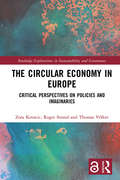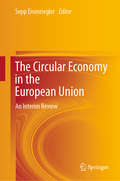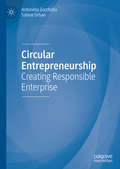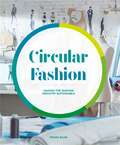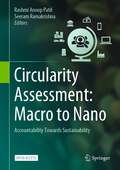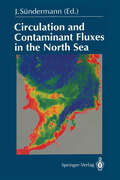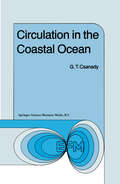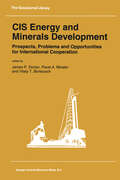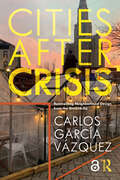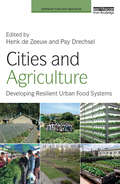- Table View
- List View
Circular Economy For Dummies
by Eric Corey Freed RitchieImagine a future free from wasted materials, labor, and energy for you, your business, and your family A circular economy is an economic system designed to save money, eliminate waste, and achieve deep sustainability. No-brainer, right? Circular Economy For Dummies explains why the old way of doing things (the take-make-waste model of a linear economy) is fast going the way of the dinosaurs, and it gets you ready to think circular. From business processes and material lifecycles to circular design in just about every industry, this book is a fascinating glimpse into the sustainable future we urgently need. Whether you’re a designer looking to create better products, a manufacturer looking to streamline your operations, or simply looking to develop a healthy and sustainable lifestyle, this book shows you how. Learn how to innovate for a circular economy, how to turn trash into treasure, and how to calculate the (potentially large) amount of money this will save you. And—bonus—you'll feel good doing the right thing and being a part of our regenerative future! Challenge the assumptions behind the old-school "linear economy" model Learn how we can work together to achieve a waste-free future Save money by rethinking your resource use or business supply chain Reimagine households, neighborhoods, schools, companies, and societies The future is circular. Buck business-as-usual and learn how to create a circular economy for all!
Circular Economy For Dummies
by Eric Corey Freed RitchieImagine a future free from wasted materials, labor, and energy for you, your business, and your family A circular economy is an economic system designed to save money, eliminate waste, and achieve deep sustainability. No-brainer, right? Circular Economy For Dummies explains why the old way of doing things (the take-make-waste model of a linear economy) is fast going the way of the dinosaurs, and it gets you ready to think circular. From business processes and material lifecycles to circular design in just about every industry, this book is a fascinating glimpse into the sustainable future we urgently need. Whether you’re a designer looking to create better products, a manufacturer looking to streamline your operations, or simply looking to develop a healthy and sustainable lifestyle, this book shows you how. Learn how to innovate for a circular economy, how to turn trash into treasure, and how to calculate the (potentially large) amount of money this will save you. And—bonus—you'll feel good doing the right thing and being a part of our regenerative future! Challenge the assumptions behind the old-school "linear economy" model Learn how we can work together to achieve a waste-free future Save money by rethinking your resource use or business supply chain Reimagine households, neighborhoods, schools, companies, and societies The future is circular. Buck business-as-usual and learn how to create a circular economy for all!
Circular Economy for the Management of Operations (Mathematical Engineering, Manufacturing, and Management Sciences)
by Anil Kumar Jose Arturo Garza-Reyes Syed Abdul Rehman KhanCircular-Economy is a new concept in operations management. Its goal is to redefine growth, focusing on positive benefits arising for society as a whole out of efficiencies such as designing waste out the operations process. This book will help practitioners use the proper strategy for effective adoption of Circular practices to use in their organization. Features: Provides a complete understanding of Circular-Economy practices Offers advanced mathematical models to help industry management adopt the correct practices Presents a deep understanding of cross-functional and customer-focused design thinking Covers how to develop sustainable practices in all types of activities within operations management. Circular Economy for the Management of Operations will be of interest to practitioners and researchers in engineering as well as business management
Circular Economy for the Management of Operations (Mathematical Engineering, Manufacturing, and Management Sciences)
by Anil Kumar Jose Arturo Garza-Reyes Syed Abdul Rehman KhanCircular-Economy is a new concept in operations management. Its goal is to redefine growth, focusing on positive benefits arising for society as a whole out of efficiencies such as designing waste out the operations process. This book will help practitioners use the proper strategy for effective adoption of Circular practices to use in their organization. Features: Provides a complete understanding of Circular-Economy practices Offers advanced mathematical models to help industry management adopt the correct practices Presents a deep understanding of cross-functional and customer-focused design thinking Covers how to develop sustainable practices in all types of activities within operations management. Circular Economy for the Management of Operations will be of interest to practitioners and researchers in engineering as well as business management
A Circular Economy Handbook: How to Build a More Resilient, Competitive and Sustainable Business
by Catherine WeetmanWINNER: 2018 Les Plumes des Achats & Supply Chain - The Committee Special Prize As we learn more about the climate and biodiversity crisis, it is clear that how we make and consume things is a major part of the problem. Extraction and processing of materials, fuels and food makes up about half of global greenhouse gas emissions and over 90% of biodiversity loss and water stress. Many modern businesses deplete resources, destroy ecosystems and dump waste and pollution at every stage - harming human health along the way. Governments, businesses and think-tanks see the circular economy as the way forward. Now in its second edition, A Circular Economy Handbook is a guided tour through the concepts and the practicalities. A unique framework systematically explores the range of circular interventions, including product and supply chain design, material choice and supporting business models. How does it really work for business? What circular approaches are emerging in food, fashion, consumer technology, packaging and other sectors? How do these reduce risk, improve resilience and build profitable, future-fit organizations? With over 300 real examples from around the world, this is a must-read for businesses, students and policymakers. This new edition has been extensively updated to include the latest trends, thinking, research and solutions, with a new chapter on packaging and 30 new company snapshots.
Circular Economy in Emergency Housing: A Research Strategy of Climate Change (SpringerBriefs in Climate Studies)
by Pilar Mercader-Moyano Paula Porras-PereiraIn recent years, there has been an upsurge in the number of forced displacements due to natural disasters, armed conflicts, and pandemics, which has favoured an increase in the number of temporary accommodations. Although the provision of shelter after an emergency situation is one of the priorities of humanitarian aid, the reality is that the conditions in which people live in a situation of forced displacement are absolutely precarious and overcrowded. Nowadays, this type of housing tends to have a short lifespan, deepening the environmental impact and the generation of waste. Likewise, added to this great problem is the linear economic system implemented worldwide, which also causes a high rate of waste.This investigation develops an eco-efficient design protocol that determines the basic premises in any emergency situation, therefore avoiding the precarious nature to which those in forced displacement are exposed. Moreover, the research investigates different constructive solutions that can respond to situations of natural catastrophes or humanitarian disasters where emergency housing is needed as well as the possible alternatives from the point of view of circular economy. Eco-efficient and environmentally correct solutions are sought, which can be adaptable to the different scenarios where emergency housing may be needed, thus creating a rapid, easy, functional, and environmentally correct architecture, adaptable to these types of situations. The study shows that the factors that characterize emergency architecture can be an example of where the issues around the sustainability factor are applied in a practical way. The main objectives of this study are to develop an eco-efficient design protocol which determines the basic premises in any emergency situation and to find eco-efficient and environmentally correct solutions, adaptable to different scenarios, which have similar climatic characteristics, and where emergency housing may be needed, thus creating a type of ephemeral architecture but sensitive to the user to whom it is intended and in accordance with the optimal conditions of habitability.
Circular Economy in Engineering Design and Production: Concepts, Methods, and Applications (Synthesis Lectures on Sustainable Development)
by Samira KeivanpourThis concise text provides the concepts, methods, and application examples for integrating sustainability into engineering design and production. It discusses the role of sustainability in the value creation processes of various enterprises and different tools and methods for systematic incorporation of social and environmental aspects into the product's life cycle. The following topics are covered: sustainable development in engineering systems and the life cycle concept, norms and standards in the sustainable development and integration of socio-economic assessment into technical valuation, production systems, management of the production systems based on circular economy principles, ecodesign practices, and value creation and innovative design in the circular economy. Provides a concise guide for engineering students for applying circular economy practicesPresents examples and short case studies for understanding the methods and toolsFacilitates understanding and application of the life cycle perspective in product manufacturing and green engineering
The Circular Economy in Europe: Critical Perspectives on Policies and Imaginaries (Routledge Explorations in Sustainability and Governance)
by Zora Kovacic Roger Strand Thomas VölkerThe Circular Economy in Europe presents an overview and a critical discussion on how circularity is conceived, imagined, and enacted in current EU policy-making. In 2013, the idea of a circular economy entered the stage of European policy-making in the efforts to reconcile environmental and economic policy objectives. In 2019 the European Commission declared in a press release that the Circular Economy Action Plan has been delivered. The level of circularity in the European economy, however, has remained the same. Bringing together perspectives from social sciences, environmental economics and policy analysis, The Circular Economy in Europe provides a critical analysis of policies and promises of the next panacea for growth and sustainability. The authors provide a theoretical and empirical basis to discuss how contemporary societies conceive their need to re-organise production and consumption and explores the messy assemblage of institutions, actors, waste streams, biophysical flows, policy objectives, scientific disciplines, values, expectations, promises and aspirations involved. This book is essential reading for all those interested in understanding how ideas about the circular economy emerged historically, how they gained traction and are used in policy processes, and what the practical challenges in implementing this policy are.
The Circular Economy in Europe: Critical Perspectives on Policies and Imaginaries (Routledge Explorations in Sustainability and Governance)
by Zora Kovacic Roger Strand Thomas VölkerThe Circular Economy in Europe presents an overview and a critical discussion on how circularity is conceived, imagined, and enacted in current EU policy-making. In 2013, the idea of a circular economy entered the stage of European policy-making in the efforts to reconcile environmental and economic policy objectives. In 2019 the European Commission declared in a press release that the Circular Economy Action Plan has been delivered. The level of circularity in the European economy, however, has remained the same. Bringing together perspectives from social sciences, environmental economics and policy analysis, The Circular Economy in Europe provides a critical analysis of policies and promises of the next panacea for growth and sustainability. The authors provide a theoretical and empirical basis to discuss how contemporary societies conceive their need to re-organise production and consumption and explores the messy assemblage of institutions, actors, waste streams, biophysical flows, policy objectives, scientific disciplines, values, expectations, promises and aspirations involved. This book is essential reading for all those interested in understanding how ideas about the circular economy emerged historically, how they gained traction and are used in policy processes, and what the practical challenges in implementing this policy are.
The Circular Economy in the European Union: An Interim Review
by Sepp EisenrieglerThe implementation of the circular economy will entail a major transformation from a resource-destroying, linear economy to a circular one that operates within the planet’s regenerative boundaries. This book presents an interim assessment of the implementation of a circular economy in the EU. It reveals what achievements have been made in various EU institutions, but which are scarcely perceived by the public; which basic scientific principles can be applied in this context; and what NGOs are demanding beyond this progress. It provides convincing arguments for abandoning the “hamster wheel” of material-based satisfaction of our needs, and shows that the primacy of the economy stands in the way of a good life for all. Given its focus, it will appeal to everyone interested in an ecologically sustainable economic system.
Circular Economy in the European Union: Organisational Practice and Future Directions in Germany, Poland and Spain (Routledge Research in Sustainability and Business)
by Dagmara Lewicka Joanna Zarębska Roman Batko Beata Tarczydło Maciej Wożniak Dariusz Cichoń Monika PecCircular Economy in the European Union: Organisational Practice and Future Directions in Germany, Poland and Spain presents the EU's journey towards a Circular Economy (CE), identifying significant organizational practices in this gradually adopted field among member countries. The book also aims to develop and propose innovative initiatives and practices for implementing CE across various economic sectors in selected EU countries, such as Poland, Spain and Germany. Covering topics which include the implementation of CE in the EU and worldwide, green employee behaviors, corporate social responsibility in creating pro-environmental attitudes and models of eco-digital factory transformation in SMEs, the book emphasizes the importance of innovative, environmentally friendly, low-waste, and low-emission technologies. Consisting of thirteen interconnected chapters, it discusses the challenges and opportunities of CE, the importance of business engagement in addressing social and environmental problems, and provides practical examples of innovative solutions in various sectors. This volume will be of great interest to students and scholars of circular economy, corporate governance, business ethics and sustainable business, as well as entrepreneurs, managers, government representatives, and non-governmental organizations active in CE.
Circular Economy in the European Union: Organisational Practice and Future Directions in Germany, Poland and Spain (Routledge Research in Sustainability and Business)
by Dagmara Lewicka Joanna Zarębska Roman Batko Beata Tarczydło Maciej Wożniak Dariusz Cichoń Monika PecCircular Economy in the European Union: Organisational Practice and Future Directions in Germany, Poland and Spain presents the EU's journey towards a Circular Economy (CE), identifying significant organizational practices in this gradually adopted field among member countries. The book also aims to develop and propose innovative initiatives and practices for implementing CE across various economic sectors in selected EU countries, such as Poland, Spain and Germany. Covering topics which include the implementation of CE in the EU and worldwide, green employee behaviors, corporate social responsibility in creating pro-environmental attitudes and models of eco-digital factory transformation in SMEs, the book emphasizes the importance of innovative, environmentally friendly, low-waste, and low-emission technologies. Consisting of thirteen interconnected chapters, it discusses the challenges and opportunities of CE, the importance of business engagement in addressing social and environmental problems, and provides practical examples of innovative solutions in various sectors. This volume will be of great interest to students and scholars of circular economy, corporate governance, business ethics and sustainable business, as well as entrepreneurs, managers, government representatives, and non-governmental organizations active in CE.
Circular Economy on Energy and Natural Resources Industries: New Processes and Applications to Reduce, Reuse and Recycle Materials and Decrease Greenhouse Gases Emissions (Sustainable Development Goals Series)
by Pedro Mora F. Gabriel Acien FernandezThis book masterfully bridges the gap between science and industry, offering readers invaluable insights into the technological advancements shaping our world. Amidst a profound industrial transformation aimed at minimizing environmental impact, this work highlights the pivotal role of reducing energy consumption and material waste. It aligns closely with the United Nations Sustainable Development Goals, encapsulating the global ambition for the coming years. The narrative delves into myriad examples of industrial evolution, showcasing how various sectors, especially energy (including electricity and oil & gas) and natural resource exploitation, are revolutionizing their processes to lessen their environmental footprint. Furthermore, each chapter of the book equips readers with the knowledge to spearhead innovative solutions tailored to these evolving processes, making it an essential resource for anyone committed to driving sustainable industrial advancements.
Circular Economy Realities: Critical Perspectives on Sustainability (Routledge/ISDRS Series in Sustainable Development Research)
by Andrea Raggi Pauline Deutz Rupert J. Baumgartner Tomás B. Ramos Walter J. V. VermeulenThis book addresses the realities of the circular economy, a resource efficiency concept that has risen to global prominence in academic, policy and business circles over the last decade. Considered an approach to sustainable growth, the volume critically analyses how sustainable emerging applications of a circular economy are in practice.The book stems from an international, interdisciplinary project exploring the discourses, policies, implementation and impacts of the circular economy across public, private and third sector accounts. It draws on a wide range of case studies, from the UK, Portugal, Austria, Italy, the Netherlands, France, Chile, China, Nigeria, Taiwan and Vietnam, highlighting how experiences both shaped and were shaped by the places in which they were happening. It provides a guide to researching a complex phenomenon such as a circular economy, which involves both collaboration and competition between multiple stakeholders across different sectors and places. Synthesising the multiple perspectives employed in the project, the book makes recommendations for circular economy implementation in different contexts, including the assessment of sustainability implications, whilst indicating the limited potential for circular economy activity to bring social and economic benefits without explicit motivation for those to happen.Benefitting from extensive empirical research, this critical assessment of sustainability in the context of the circular economy will appeal to a broad readership of academics, upper-level students, practitioners and policy-makers in sustainable development, business, economics, geography, sociology and environmental engineering.The Open Access version of this book, available at http://www.taylorfrancis.com, has been made available under a Creative Commons Attribution-Non Commercial-No Derivatives (CC-BY-NC-ND) 4.0 license.
Circular Economy Realities: Critical Perspectives on Sustainability (Routledge/ISDRS Series in Sustainable Development Research)
by Andrea Raggi Pauline Deutz Vermeulen, Walter J.V. Rupert J. Baumgartner Tomás B. RamosThis book addresses the realities of the circular economy, a resource efficiency concept that has risen to global prominence in academic, policy and business circles over the last decade. Considered an approach to sustainable growth, the volume critically analyses how sustainable emerging applications of a circular economy are in practice.The book stems from an international, interdisciplinary project exploring the discourses, policies, implementation and impacts of the circular economy across public, private and third sector accounts. It draws on a wide range of case studies, from the UK, Portugal, Austria, Italy, the Netherlands, France, Chile, China, Nigeria, Taiwan and Vietnam, highlighting how experiences both shaped and were shaped by the places in which they were happening. It provides a guide to researching a complex phenomenon such as a circular economy, which involves both collaboration and competition between multiple stakeholders across different sectors and places. Synthesising the multiple perspectives employed in the project, the book makes recommendations for circular economy implementation in different contexts, including the assessment of sustainability implications, whilst indicating the limited potential for circular economy activity to bring social and economic benefits without explicit motivation for those to happen.Benefitting from extensive empirical research, this critical assessment of sustainability in the context of the circular economy will appeal to a broad readership of academics, upper-level students, practitioners and policy-makers in sustainable development, business, economics, geography, sociology and environmental engineering.The Open Access version of this book, available at http://www.taylorfrancis.com, has been made available under a Creative Commons Attribution-Non Commercial-No Derivatives (CC-BY-NC-ND) 4.0 license.
Circular Entrepreneurship: Creating Responsible Enterprise
by Antonella Zucchella Sabine UrbanThis original book explores how the principles of circularity, considered a law of nature but neglected within the materialistic orientation of the industrial age, are becoming attractive again in business and society. Investigation reveals enterprises small and large delivering a stimulating message, from changes in entrepreneurial mindsets to the inclusive use of new technologies and a push for innovation. Zucchella and Urban explore the novel concept of circular enterprise, showing how, with their capacity to innovate, these firms are becoming the most powerful actors of a new, sustainable social order. They examine two fundamental questions: why is this revolution occurring now, and how is it being implemented? Focusing on the most innovative practices, they demonstrate the potential of circular enterprise for industry and wider society, making clear that a new world is emerging.
Circular Fashion: Making the Fashion Industry Sustainable
by Peggy BlumCreating sustainable fashion has never been more important. Circular Fashion provides an accessible, practical, and holistic approach to this key topic for anyone studying fashion.This introductory text to sustainability in fashion includes best practice case studies and profiles of key companies such as Patagonia, Veja, Christopher Raeburn, and Stella McCartney. It begins with an overview of the fashion business, tackling the issues of the linear production model of make, use, dispose, before introducing the idea of the circular supply chain.Circular Fashion is the must-have book for fashion students, creatives and anyone passionate about sustainability and fashion.
Circularity Assessment: Accountability Towards Sustainability
by Rashmi Anoop Patil Seeram RamakrishnaThis open access book attempts to provide a perspective on the circularity assessment at different levels of the systemic hierarchy and advocates better resource management for a sustainable future. It demonstrates how relevant circularity indicators are used for quantifying the extent of circularity of each level. Illustrative case studies that discuss the process of quantitatively interpreting progress towards circularity are provided. This work caters to a broad readership inclusive of governance, basic research, engineering, and business stakeholders. The conclusion signifies the role of consumer community in achieving circularity.
Circulation and Contaminant Fluxes in the North Sea
by Jürgen SündermannIn this publication you will find a comprehensive data set of the North Sea ecosystem, including the distribution and the fate of contaminants, their transport paths and their analysis by means of numerical models. This book presents the results of the interdisciplinary German research project ZISCH ('Zirkulation und Schadstoffumsatz in der Nordsee') encompassing oceanographers, meteorologists, marine biologists and chemists.
Circulation in the Coastal Ocean (Environmental Fluid Mechanics #2)
by G.T. CsanadyFor some time there has existed an extensive theoretical literature relating to tides on continental shelves and also to the behavior of estuaries. Much less attention was traditionally paid to the dynamics of longer term, larger scale motions (those which are usually described as circulation') over continental shelves or in enclosed shallow seas such as the North American Great Lakes. This is no longer the case: spurred on by other disciplines, notably biological oceanography, and by public concern with the environment, the physical science of the coastal ocean has made giant strides during the last two decades or so. Today, it is probably fair to say that coastal ocean physics has come of age as a deduc tive quantitative science. A well developed body of theoretical models exist, based on the equations of fluid motion, which have been related to observed currents, sea level variations, water properties, etc. Quantitative parameters required in using the models to predict e.g. the effects of wind or of freshwater influx on coastal currents can be estimated within reasonable bounds of error. While much remains to be learned, and many exciting discoveries presumably await us in the future, the time seems appropriate to summarize those aspects of coastal ocean dynamics relevant to 'circulation' or long term motion.
Cirrus
by David K. Lynch Kenneth Sassen David O'C. Starr Graeme StephensCirrus clouds are high, thin, tropospheric clouds composed predominately of ice. In the last ten years, considerable work has shown that cirrus is widespread--more common than previously believed--and has a significant impact on climate and global change. As the next generation weather satellites are being designed, the impact of cirrus on remote sensing and the global energy budget must be recognized and accommodated. This book, the first to be devoted entirely to cirrus clouds, captures the state of knowledge of cirrus and serves as a practical handbook as well. Each chapter is based on an invited review talk presented at Cirrus, a meeting hosted by the Optical Society of America and co-sponsored by the American Geophysical Union and the American Meteorological Society. All aspects of cirrus clouds are covered, an approach that reaches into diverse fields. Topics include: the definition of cirrus, cirrus climatologies, nucleation, evolution and dissipation, mixed-phase thermodynamics, crystallinity, orientation mechanisms, dynamics, scattering, radiative transfer, in situ sampling, processes that produce or influence cirrus (and vice versa), contrails, and the influence of cirrus on climate.
CIS Energy and Minerals Development: Prospects, Problems and Opportunities for International Cooperation (GeoJournal Library #25)
by James P. Dorian, Pavel A. Minakir and Vitaly T. BorisovichThe former Soviet Union possessed some of the world's largest reserves of energy and mineral resources. With the dissolution of the country in 1991, the former Soviet republics are now exercising complete control over their mining industries. The new Commonwealth of Independent States (CIS) consists of several new nations, well-endowed in hydrocarbons, metals, and industrial materials; efforts are now underway to boost development activities and attract foreign investment. Commonwealth members today are implementing policies to regulate energy and mineral development and enhance economic growth. This book provides a comprehensive overview of the energy and minerals industries of the CIS and other former Soviet republics outside the Commonwealth. Prospects for international cooperation and trade in hydrocarbons, metals, and nonmetals are examined, as are opportunities for joint ventures and technology transfers in mining. Economic relations between the CIS and several Asian nations are also analyzed. Contributors to the book from throughout the Commonwealth, Asia, Europe, and North America have a wide variety of backgrounds in the energy and mineral fields, including government, academia, and industry.
Cities After Crisis: Reinventing Neighborhood Design from the Ground-Up
by Carlos Garcia VazquezCities After Crisis shows how urbanism and urban design is redefining cities after the global health, economic, and environmental crises of the past decades. The book details how these crises have led to a new urban vision—from avantgarde modern design to an artisan aesthetic that calls for simplicity and the everyday, from the sustainable development paradigm to a resilient vision that defends de-growth and the re-wilding of cities, from a homogenizing globalism to a new localism that values what is distinctive and nearby, from the privatization of the public realm to the commoning and self-governance of urban resources, and from top-down to bottom-up processes based on the engagement and empowerment of communities. Through examples from cities around the world and a detailed look at the London neighbourhood of Dalston, the book shows designers and planners how to incorporate residents into the decision-making process, design inclusive public spaces that can be permanently reconfigured, reimagine obsolete spaces to accommodate radically contemporary uses, and build gardens designed and maintained by the community, among other projects.
Cities After Crisis: Reinventing Neighborhood Design from the Ground-Up
by Carlos Garcia VazquezCities After Crisis shows how urbanism and urban design is redefining cities after the global health, economic, and environmental crises of the past decades. The book details how these crises have led to a new urban vision—from avantgarde modern design to an artisan aesthetic that calls for simplicity and the everyday, from the sustainable development paradigm to a resilient vision that defends de-growth and the re-wilding of cities, from a homogenizing globalism to a new localism that values what is distinctive and nearby, from the privatization of the public realm to the commoning and self-governance of urban resources, and from top-down to bottom-up processes based on the engagement and empowerment of communities. Through examples from cities around the world and a detailed look at the London neighbourhood of Dalston, the book shows designers and planners how to incorporate residents into the decision-making process, design inclusive public spaces that can be permanently reconfigured, reimagine obsolete spaces to accommodate radically contemporary uses, and build gardens designed and maintained by the community, among other projects.
Cities and Agriculture: Developing Resilient Urban Food Systems (Earthscan Food and Agriculture)
by Henk De Zeeuw Pay DrechselAs people increasingly migrate to urban settings and more than half of the world's population now lives in cities, it is vital to plan and provide for sustainable and resilient food systems which reflect this challenge. This volume presents experience and evidence-based "state of the art" chapters on the key dimensions of urban food challenges and types of intra- and peri-urban agriculture. The book provides urban planners, local policy makers and urban development practitioners with an overview of crucial aspects of urban food systems based on an up to date review of research results and practical experiences in both developed and developing countries. By doing so, the international team of authors provides a balanced textbook for students of the growing number of courses on sustainable agriculture, food and urban studies, as well as a solid basis for well-informed policy making, planning and implementation regarding the development of sustainable, resilient and just urban food systems.





